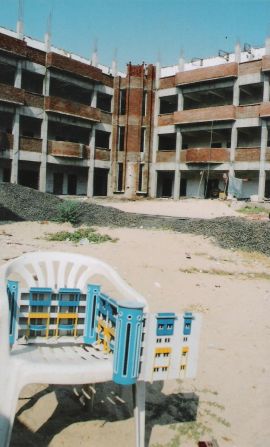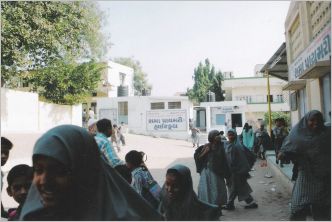It's difficult to imagine that the bare red bricks and the jutting iron rods of a school building that's under construction can symbolise the hopes, aspirations and struggles of an entire community. But the walls of this work-in-progress in Ahmedabad mirror the story of Gujarat's Muslims, who, after the riots of 2002, have been confined to areas that have no educational, medical or indeed any civic facility. The school, which its builders plan to paint in blue, white and yellow, is meant to alter a partisan, possibly state government-approved script of ensuring that Muslim children have little by way of support for education in an area conveniently labelled a Muslim-ghetto and forgotten.
"Our family trust purchased this building," says Sharifkhan N Pathan of Nawab Builders, who is now remodelling the old structure to create more space for the school. "We had to start it compulsorily," he offers by way of explanation. "Teachers harass our children when they go to the schools located outside Muslim pockets. So we decided it was best to build our own schools."

![]() A school being set up by Nawab Builders. In front, on a chair, is the school's model. Pic: Deepa A.
A school being set up by Nawab Builders. In front, on a chair, is the school's model. Pic: Deepa A.
Ahmedabad's topography, today defined almost entirely by religion, seems to be motivating the likes of Pathan to set up schools in areas that are Muslim pockets. After the riots, in which, according to Gujarat Government figures, over a 1,000 people a majority of them Muslims were killed, the city has been clearly demarcated into Hindu and Muslim areas, with the 'borders' in between representing the extent of the divide. If the Hindu areas have Dominoes and Café Coffee Days, the Muslim pockets have dusty, un-tarred roads lined by sooty tyre shops. Each school that is set up in a Muslim-dominated locality, therefore, is an attempt to circumvent a future that has already been determined according to stereotypes.
Afsal M Memon, a businessman and social worker who started a school in Danilimda in 2004, says the Muslim community does feel the need to ensure that the children receive a modern education. "But Muslims won't send their children to other areas the non-Muslims behave badly with them," he adds. Just over two years after Memon started the school, it runs in two shifts, and has over 1,000 students, says Nazneen U G, the high school section principal. Those numbers are indicators of many things: a community's desperation for a school with a roof and teachers, the Gujarat Government's refusal to help, and the shoddy way in which the few if any municipal schools are run in areas where Muslims have sought safety in numbers.
Six classrooms, 650 children
At a Muslim-dominated locality in Ahmedabad's Old City area is a municipality-run Urdu school that is located on the first floor of a crumbling building. A steep staircase next to two unclean toilets leads up to a tiny corridor, on one side of which are the classrooms, crammed with students sitting on the floor. The principal's office has space for one chair and a table; visitors have to squat on a low, rickety bench next to her chair. The principal, who requests anonymity for fear of government reprimand, reels out appalling statistics in between answering the questions of several children walking in and out of her office. In the six tiny classes that make up the school, there are 425 children in the upper primary section. From the first to the third standards, she estimates there are 650 children. The school manages to accommodate the 1,000-odd children in two shifts. "You can see the school's condition," she says. "There are many problems here."
The increase was sought accommodate children who have been turned away elsewhere or who simply have no other option.

•
Still suffering, five years after
•
Conflict hurts dalits' schooling
Juhapura, referred to as the largest Muslim ghetto in Gujarat, has a few schools started by Muslim trusts. But the number of seats is still insufficient to meet the requirements of the over three hundred thousand people estimated to live here. Noorjahan Diwan, who is a volunteer with Aman Samuday, a group that works for communal harmony, says there are no higher secondary schools in Juhapura; the colleges are in Hindu-dominated localities, and parents feel it's unsafe to send their children there. The few municipal schools in Juhapura do not have an environment conducive for learning either, she says. "Gambling goes on in one of the schools, and there is so much riff-raff that parents don't want to send their children to study," says Diwan. "There is another municipal school, but next to it is an illegal liquor brewing shop."
The question of language
Given the horrific conditions, it's not surprising that the initiative to set up schools has come from the community itself. "In Muslim ghettos, because nothing else is available to them, Muslim groups have started schools," says Lakdawala. Most of these are Gujarati-medium schools, and a few offer English-medium as well. Hardly any Urdu schools are being set up.
Javed Ameer, programme manager of the NGO Action Aid, and earlier the director of an NGO called Society for Education, Empowerment and Development (SEED), says that Urdu is not the mother tongue of the Gujarati Muslim; besides, people understand that it is necessary to know Gujarati to make a living. Shakeel Ahmad, administrator of the Islamic Relief Committee-Gujarat's cell for legal help and guidance, and general secretary of the Forum for Democracy and Communal Amity (Gujarat), notes that most of the existing Urdu-medium schools are in places that have a migrant Muslim population, whose mother tongue could be Urdu.

![]() Children at a school in Danilimda; the school was started by businessperson and social worker Afsal Memon, who felt there were not enough educational facilities in Muslim-dominated areas. Pic: Deepa A.
Children at a school in Danilimda; the school was started by businessperson and social worker Afsal Memon, who felt there were not enough educational facilities in Muslim-dominated areas. Pic: Deepa A.
Edwin Masihi, a sociologist who had conducted a study for SEED in 2000 on the issues affecting the spread of formal education among Muslim communities in Ahmedabad and Banaskantha districts, says there are hardly any Urdu-medium secondary schools in Gujarat. "If children have to study beyond the primary level, they have to go to English or Gujarati-medium schools," he adds. This could also have been a factor in new school managements deciding on Gujarati or English as the medium of instruction.
In fact, after the riots of 2002, the number of Urdu-medium schools in Ahmedabad has actually gone down, perhaps because of the internal displacement that has occurred since then. With Muslims moving out of Hindu-dominated localities, it is possible that the Urdu schools there have shut down. While there were 92 Urdu-medium civic schools before the riots, figures sourced from the Ahmedabad Municipal Corporation show that today there are only 76.
One roadblock too many
The state government, which seems to consider Muslim pockets as wastelands, has shown remarkable alacrity in creating problems for Muslim trusts interested in setting up schools. Says Ahmad, "In many meetings, we have complained about the difficulties of school managements. Already, there are several restrictions as far as starting schools are concerned, but in a hostile atmosphere, it becomes even more difficult." Adds Lakdawala, "Most school authorities don't fulfill all the yardsticks mandatory for getting permission to start a school, such as having a playground, for instance. But in the case of Muslim trusts, they make sure that permission is given only if all the rules are followed. At one level, this is genuine, but the fact is that, with all these problems, other schools will get permission."
Indeed, several prominent educationists and activists, including Gagan Sethi, of the NGO Jan Vikas, and Achyut Yagnik, of the NGO Centre for Social Knowledge and Action and co-author of the book The Shaping of Modern Gujarat, made a representation to the Sachar Committee (led by former Chief Justice of the Delhi High Court, Rajinder Sachar) in February 2006 about the discriminatory practices in education. Among other things, the representation mentioned that Muslim trusts were being forced to use their own resources to set up schools due to lack of government aid.
In some cases, the education department has not even approved the requests of Muslim trusts to increase the number of seats so as to accommodate children who have been turned away elsewhere or who simply have no other option. For instance, Ameer gives the example of a well-known Muslim education trust that wanted to increase the number of classes at its school in Juhapura, on its own, without getting any government grant. "But they didn't get the necessary permission," he says. Adds Memon, "We are not treated with a positive attitude. Many obstacles are placed in our way, and one gets worn-out facing one problem after the other. The idea seems to be to force a person to give up."
Is quality a luxury?
In the face of several restrictions, when a Muslim trust sets up a school, it is difficult to criticise its intentions. Yet there are concerns about quality, arising because of several reasons. As a principal of a school in Ahmedabad's Old City area, who requests anonymity, says, those setting up schools are not from the education field. "They are starting schools because they feel there is a need," she explains. Many of these trusts, however, try to make amends for the lack of expertise by setting up advisory committees with educationists, she adds.
Nevertheless, quality is often lacking in these schools, says Lakdawala. Ameer adds that the managements seldom place any emphasis on teacher training. Just as worrisome is the fear that these schools may shape an identity that's centred on religion. Says Lakdawala, "They say the schools are secular but certain groups impose restrictions on girls in some cases, girls are taught only till the fourth or fifth standard. Even small girls wear chaddar or naqab in these schools, and the teachers do namaaz."
Besides, the atmosphere at these institutes, just as it is in schools with only Hindu children, tend to be "monotonous", says Professor Mohaiyuddin G Bombaywala, director of the Hazrat Pirmohammed Shah Library and Research Centre, Ahmedabad. One group has no idea about the other, and the environment nurtures prejudices and stereotypes.
In addition, many privately run schools in areas where riot victims have moved to, such as Vatva and Faisal Park, charge fees that are beyond the means of parents struggling to make a living. Says Farzana S Shaikh, manager of the NGO Mahila Patchwork Co-operative Society, which works with Muslim women, "Poor people can't send their children to private schools. In each house, there will be three-four children, how can the parents then send all their children to school?" Adds Afroz Baig of the NGO Samerth, which works in the field of education and development, "Private schools are only for those who can afford it. Today, the internal displacement after the riots has affected livelihoods. People don't even get food for one meal a day, why would they concentrate on education?" For Gujarat's embattled Muslim community, there are no easy answers.























